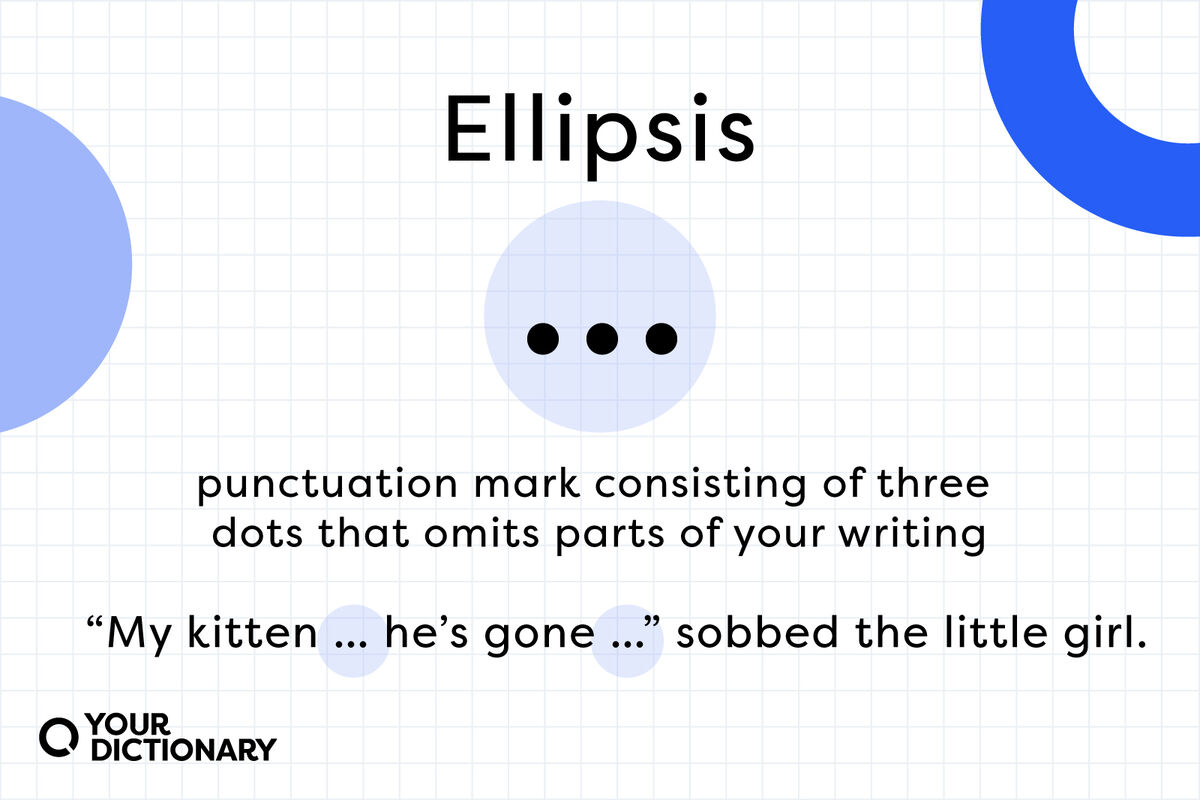
An ellipsis (plural ellipses) is a punctuation mark that consists of three dots or periods (...) in writing. Also known as suspension points or even dot-dot-dot, ellipses appear in informal writing, news stories, and fiction.
Both ellipsis and ellipses come from the Greek élleipsis, meaning “falling short” or “omission” — which is what ellipses do. They omit parts of your writing.
Examples of Ellipses in Sentences
You’ll see ellipses in a variety of different sentences, but essentially, they always do the same thing: They replace missing text, whether it’s a word, a sentence, or several paragraphs.
- The witness described a “middle-aged man … who drove a Dodge Stratus.” (Ellipsis replaces irrelevant details)
- “My kitten … he’s gone …” sobbed the little girl. (Ellipses show pauses in speaking)
- “Have you seen …” Hannah stopped speaking as Jake walked in. (Ellipsis replaces missing words as dialogue trails off)
How To Use an Ellipsis
Reporters and fiction writers tend to use ellipses more than academic writers. However, ellipses can be helpful in all three types of writing.
Use an Ellipsis for Omission in News Reports
When news reports include a longer quote, parts of the quote may be unnecessary to the story. An ellipsis can replace this unnecessary part of the quote.
For example, if a fire broke out and a fire chief gave the following quote, most of the quote would likely be considered unnecessary.
- without an ellipsis - "We've determined positively, absolutely, beyond the shadow of a doubt, drawing our conclusions from all the available data, understanding the impact of the recent spate of arsons, that this fire was accidental."
- with an ellipsis - "We've determined positively … that this fire was accidental."
Readers get the same idea in a shorter amount of time with the second sentence. The newspaper saves valuable space for more information, and the readers don't need to spend time with unnecessary wording.
Use an Ellipsis for Omission in Formal Writing
The same rule applies to formal writing, such as academic papers and published research, when a quote might be too long or clunky.
For example, a discussion of search and seizure might invoke part of the Fourth Amendment, but not all of it:
- without ellipses - "The right of the people to be secure in their persons, houses, papers, and effects, against unreasonable searches and seizures, shall not be violated, and no Warrants shall issue, but upon probable cause, supported by Oath or affirmation, and particularly describing the place to be searched, and the persons or things to be seized."
- with ellipses - "The right of the people to be secure … against unreasonable searches and seizures, shall not be violated …."
Using Ellipses To Show Pauses in Dialogue
In fiction, an ellipsis can demonstrate a pause in dialogue or a character "trailing off" (stopping talking without finishing their sentence).
- He stammered, "Please ... tell my son ... that I love him ..."
- My mother put the phone to her ear. "Hello? ... Yes, this is Kay ... no, I'm not interested in a subscription ..."
- "Are you ... are you serious?"
- "I've been wondering ... and I hope you agree ... that we should be married."
Longer pauses show that the character is speaking in a drawn-out way, while ellipses at the end of quotes show that the character has trailed off for some reason.
Ellipses in Texting and Social Media
21st-century ellipses may be even more significant than earlier versions. After all, ellipses take on many more meanings in text conversations and social media platforms, even beyond the dreaded waiting-to-reply ellipsis icon.

Adding an ellipsis to a standard reply could create a whole new emotional response, since it feels like there’s a “but” waiting afterward (or something even more sinister).
- I really like you.
- I really like you …
- Your wedding was beautiful!
- Your wedding was beautiful …
- I’m waiting outside.
- I’m waiting outside …
You may also see an ellipsis after a question (Are you coming to the party, or …) to add a slight tone of impatience or annoyance.
And an ellipsis by itself could mean “I don’t get it” or “I’m speechless,” depending on the comment it’s responding to.
When Shouldn't You Use Ellipses?
An ellipsis can be a very effective punctuation tool. However, when ellipses are overused or used incorrectly, they can make writing feel plodding. Avoid using ellipses:
- to indicate a pause in narration (use a comma instead)
- instead of "um" in narration (create new, full sentences instead)
- to cut out large chunks of an important quotation (choose a more specific quotation instead)
- to interrupt text (use an em dash instead)
The main rule of ellipses is not to overuse them. When in doubt, find a different way to write your sentence to avoid the ellipsis unless you know exactly why you're using it.
Do You Put Spaces in an Ellipsis?
Ellipses can appear with or without spaces. It all depends on the style guide you’re using.
- MLA, Chicago, and APA manuals of style use spaces between each dot [ . . . ] as well as on each side of the ellipsis.
- AP style guide prefers no spaces between the dots [ … ] but uses spaces on either side of the ellipsis.
Many word processors will automatically format an ellipsis character if you type three periods in a row. However, if you use spaces, it won’t change the formatting.
Are Ellipses Always Three Dots?
One day, you may encounter a rare specimen: the four-dot ellipsis. Surely it’s a typo. Don’t ellipses always have three dots, not four?
That first dot isn’t part of the ellipsis — it’s the period for the complete sentence before it. In styles that space out ellipses, that period can look like a fourth dot.
- Patrick Henry said, “Power is the great evil with which we are contending. . . . However, where is the check on the power of the judiciary?”
- As José Rizal says in Noli Me Tángere, “Your enemies hate you more than they hate your ideas. . . . Once you are defeated let the humblest-looking among you sponsor it and your enemies to humble you will approve it.”
You only need to worry about including a period before an ellipsis if the sentence before it is a full sentence, and you’re omitting part or all of the sentence after it. The same rule applies for sentences that end in an exclamation mark or question mark.